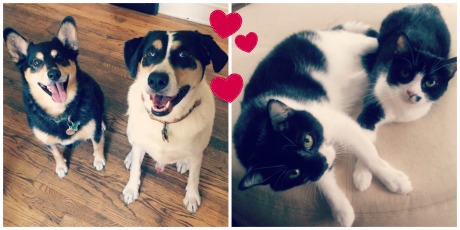Despite the common belief that cats and dogs are natural enemies, many pet owners can testify that their feline and canine companions can actually get along quite well. As someone who works with dogs professionally, I am also a self-proclaimed “cat person” and have always enjoyed observing the interactions between these two species. It raises questions like: Do they understand each other? Are conflicts a result of miscommunication?
In my role as a trainer, I believe it is important to have a comprehensive understanding of both cat and dog behavior. Based on my research and experience, I have identified 5 ways in which our pets communicate similarly, as well as 5 common misunderstandings. By shedding light on these aspects, I hope to provide you with a fresh perspective on your own pets’ interactions.
5 Misunderstandings between Cats and Dogs
Tail Position
The position of a tail can convey different meanings depending on the species. A loosely-wagging dog tail is typically seen as a sign of friendliness, while a cat’s tail whipping back and forth indicates agitation and potential aggression. This similarity in tail movement can lead to confusion between the two species.
Meeting and Greeting
Cats prefer a nose-to-nose greeting, while dogs opt for a more direct nose-to-butt approach. Each species may find the other’s greeting style to be rude or off-putting.
Vocalizations
Dogs bark and cats meow as a way to seek attention, but these sounds do not easily translate across species. Additionally, dogs do not have an equivalent to the hissing and purring sounds that cats make. However, dogs generally understand that a hiss is a warning to back off.
Rolling Over and Raising a Paw
For dogs, rolling over is a sign of submission and non-aggression. However, cats often roll onto their backs before launching into playfully biting or scratching. Similarly, when a cat raises a paw, it may be misunderstood by a dog as an invitation to play or seek attention, leading to a potential confrontation.
Ears
Ears can serve as subtle signals of aggression or fear. Cats hold their ears forward, up, and to the side when fearful, while dogs hold their ears back and flat when they feel threatened. This distinction can cause a dog to misinterpret a cat’s intentions.
5 Ways Cats and Dogs Understand Each Other
Vocalizations
Certain vocalizations, such as shrieks, yelps, and growls, are universally recognized by both cats and dogs as signals of pain, fear, or aggression.
Eye Movements
Both cats and dogs use blinking and soft eye contact to communicate that they mean no harm or are in a friendly state. On the other hand, intense staring can be seen as a challenge or threat. Fearful cats and dogs also display “whale-eye,” showing the whites of their eyes.
Facial Expressions
Tension in the mouth area is a common indicator of aggression for both dogs and cats. When threatened, both species push their whiskers forward.
Grooming
If your cat and dog groom each other, consider them best friends. This behavior, known as allogrooming, is a sign of utmost affection and trust between the two.
Resting Together
When cats and dogs choose to lie down and relax near each other, it indicates a level of comfort and trust. The closer they are to each other, the stronger their bond. Some pets may even engage in adorable activities such as spooning.
Now, it’s time for you to reflect on your own pets’ behavior:
- How do your cats and dogs get along?
- What signals do they give each other?
Frequently Asked Questions
Q: What can I do to improve the relationship between my cat and dog?
A: It’s essential to provide each pet with their own space and resources, such as separate feeding areas and litter boxes. Gradual introduction and positive reinforcement can also help them feel more comfortable around each other.
Q: Is it common for cats to groom dogs?
A: Yes, some cats display motherly or nurturing behavior towards dogs and may groom them as a sign of affection.
Q: Can cats and dogs become best friends?
A: Absolutely! With proper introductions, socialization, and ongoing monitoring, cats and dogs can form deep bonds and become inseparable companions.
Conclusion
Despite their differences, cats and dogs have the ability to communicate and understand each other in their own unique ways. By recognizing these signals and behaviors, we can foster harmonious relationships between our beloved pets. Remember, every cat and dog is an individual, and their interactions may vary. So, embrace the fascinating connection between these two species and enjoy the love and joy they bring to our lives.
For more informative content on pets, please visit Pawsoha.
Lynda manages our dog walking team at Rover-Time. Her career focus is on dog training and behavior, and she believes in using scientifically-based, positive reinforcement methods to improve the relationship between humans and their pets. In the evenings, she also assists as a trainer at Animal Sense. At home, Lynda co-parents her own cat and two dogs, Surf and Ryan, with her partner, Mary.
